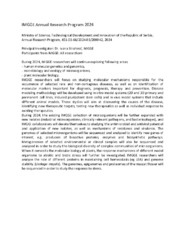Приказ основних података о документу
IMGGE Annual Research Program 2024
| dc.date.accessioned | 2024-02-12T22:27:28Z | |
| dc.date.available | 2024-02-12T22:27:28Z | |
| dc.date.issued | 2024 | |
| dc.identifier.uri | https://imagine.imgge.bg.ac.rs/handle/123456789/2316 | |
| dc.description.abstract | During 2024, IMGGE researchers will continue exploring following areas: - human molecular genetics and genomics, - microbiology and ecology of microorganisms, - plant molecular biology. IMGGE researchers will focus on studying molecular mechanisms responsible for the occurrence of selected rare and non-contagious diseases, as well as on identification of molecular markers important for diagnosis, prognosis, therapy and prevention. Disease modeling methodology will be developed using in vitro model systems (2D and 3D primary and permanent cell lines, induced pluripotent stem cells) and in vivo model systems that include different animal models. These stydies will aim at discovering the causes of the disease, identifying new therapeutic targets, testing new therapeutics as well as individual response to existing therapeutics. During 2024, the existing IMGGE collection of microorganisms will be further expanded with new isolates (industrial microorganisms, clinically relevant pathogens, and bacteriophages), and IMGGI collaborators will devote themselves to studying the antimicrobial and antiviral potential and application of new isolates, as well as mechanisms of resistance and virulence. The genomes of selected microorganisms will be sequenced and analyzed to identify new genes of interest, e.g. producers of bioactive proteins, enzymes and biosynthetic pathways. Metagenomes of selected environmental or clinical samples will also be sequenced and analyzed in order to study the biological diversity of complex communities of microorganisms. When it comes to the molecular biology of plants, the response mechanisms of different model organisms to abiotic and biotic stress will further be investigated. IMGGE researchers will analyze the role of different proteins in maintaining cell homeostasis (eg LEA) and genome stability (Ustilago maydis). The genomes, epigenomes and proteomes of the muscat flower will be sequenced in order to study the response to stress. | sr |
| dc.language.iso | en | sr |
| dc.relation | info:eu-repo/grantAgreement/MESTD/inst-2020/200042/RS// | sr |
| dc.rights | openAccess | sr |
| dc.rights.uri | https://creativecommons.org/licenses/by/4.0/ | |
| dc.source | Ministry of Science, Technological Development and Innovation of the Republic of Serbia, Annual Research Program | sr |
| dc.subject | human molecular genetics and genomics | sr |
| dc.subject | microbiology and ecology of microorganisms | sr |
| dc.subject | microbiology and ecology of microorganisms | sr |
| dc.subject | plant molecular biology | sr |
| dc.title | IMGGE Annual Research Program 2024 | sr |
| dc.type | other | sr |
| dc.rights.license | BY | sr |
| dc.description.other | Principal Investigator: Dr. Ivana Strahinić, IMGGE | sr |
| dc.description.other | Duration period: 2024 | |
| dc.identifier.fulltext | https://imagine.imgge.bg.ac.rs/bitstream/id/640075/Ivana Strahinic NITRA 2024 - Programi IMGGI za promociju molekularne biologije.pdf | |
| dc.identifier.rcub | https://hdl.handle.net/21.15107/rcub_imagine_2316 | |
| dc.type.version | publishedVersion | sr |

